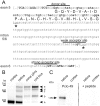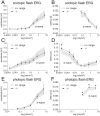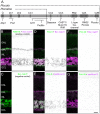Identification and immunocytochemical characterization of Piccolino, a novel Piccolo splice variant selectively expressed at sensory ribbon synapses of the eye and ear
- PMID: 23936420
- PMCID: PMC3735604
- DOI: 10.1371/journal.pone.0070373
Identification and immunocytochemical characterization of Piccolino, a novel Piccolo splice variant selectively expressed at sensory ribbon synapses of the eye and ear
Abstract
Piccolo is one of the largest cytomatrix proteins present at active zones of chemical synapses, where it is suggested to play a role in recruiting and integrating molecules relevant for both synaptic vesicle exo- and endocytosis. Here we examined the retina of a Piccolo-mutant mouse with a targeted deletion of exon 14 in the Pclo gene. Piccolo deficiency resulted in its profound loss at conventional chemical amacrine cell synapses but retinal ribbon synapses were structurally and functionally unaffected. This led to the identification of a shorter, ribbon-specific Piccolo variant, Piccolino, present in retinal photoreceptor cells, bipolar cells, as well as in inner hair cells of the inner ear. By RT-PCR analysis and the generation of a Piccolino-specific antibody we show that non-splicing of intron 5/6 leads to premature translation termination and generation of the C-terminally truncated protein specifically expressed at active zones of ribbon synapse containing cell types. With in situ proximity ligation assays we provide evidence that this truncation leads to the absence of interaction sites for Bassoon, Munc13, and presumably also ELKS/CAST, RIM2, and the L-type Ca(2) (+) channel which exist in the full-length Piccolo at active zones of conventional chemical synapses. The putative lack of interactions with proteins of the active zone suggests a function of Piccolino at ribbon synapses of sensory neurons different from Piccolo's function at conventional chemical synapses.
Conflict of interest statement
Figures







References
-
- Gundelfinger ED, Fejtová A (2012) Molecular organization and plasticity of the cytomatrix at the active zone. Curr Opin Neurobiol 22: 423–30. - PubMed
-
- Zhai RG, Bellen HJ (2004) The architecture of the active zone in the presynaptic nerve terminal. Physiology (Bethesda) 19: 262–70. - PubMed
-
- tom Dieck S, Brandstätter JH (2006) Ribbon synapses of the retina. Cell Tissue Res 326: 339–46. - PubMed
Publication types
MeSH terms
Substances
LinkOut - more resources
Full Text Sources
Other Literature Sources
Molecular Biology Databases
Miscellaneous

